 by Peter Walker and Pieter Thomassen with Rob Morgenstern
by Peter Walker and Pieter Thomassen with Rob Morgenstern
| | | | | |
Veritech Armored Cyclone
VR-038 Bartley, -041 Blowsperior, -052 Battler, -055 Devastator
|

|

|
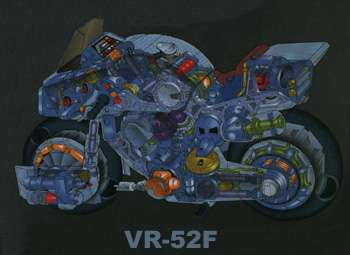
|
 |
 |  |  |  |  |  |
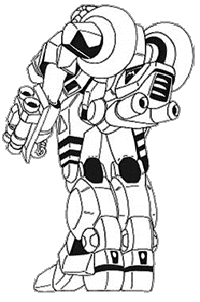
I. Dimensions
| | -038 | -041,-052 | -055 |
| A. Motorcycle mode |
| Total Height: | 1.09m | 1.09m | 1.29m |
| Total Width: | 0.50m | 0.50m | 0.50m |
| Total Length: | 2.05m | 2.05m | 2.41m |
| B. Battloid mode |
| Total Height: | 2.10m | 2.30m | 2.50m |
| Total Breadth: | 1.03m | 1.03m | 1.03m |
| Total Depth: | 1.60m | 1.60m | 1.70m |
| Total Weight: | 72 kg | 132kg | 169kg |
II. Type:
- One man motorcycle, two-form veritech high-mobility power armor.
III. Service History:
- -038: Served with all branches of the REF from 2028.
- -041: Served with the REF Army and Marines from 2030.
- -052: Served with all branches of the REF from 2032.
- -055: Served with the REF Army and Marines in limited numbers from 2043.
IV. Performance:
- Speed, Motorcycle mode : 220kph max., 128kph typical cruising speed
- Speed, Battloid (running): Approximately equal to that of the pilot.
- Speed, Battloid (flying) : 185 kph at up to 61m, hover at 9.1m
- Max Output: 98hp / 16000rpm
- Protoculture supply : 100 hours operational use, on one standard protoculture cell (except the VR-055, which uses two).
- Typical Range: 380 km.
V. Electronics:
(-038 Bartley, -041 Blowsperior)
- Harris CT-12 computer targeting system and HUD in Battloid mode.
- Short range radio.
(-052 Battler)
- Avionica VR-34 short range millimeter radar (3 km range).
- Phillips Miniview UV, IIR and optical sight system with light intensifier and computer
enhancement.
- Harris CT-12B computer targeting system with stereoscopic laser targeting and HUD in
Battloid mode.
- Short range radio.
(-055 Devastator)
- As with the -052, but the targeting sensors are capable of a traverse up to +20 and -60 degrees in altitude above the horizon.
Note: All externally-mounted Cyclone weapons have integral laser designators built in, and the Cyclone is designed to detect and use the laser 'paint' for the targeting of the weapons.
VI. Personal Armor:
To use the Cyclone, the pilot must be wearing a suit of CVR-3M or -3F body armor, to which the Cyclone attaches in Battloid mode. The introduction of the VR-055R Devastator required minor modifications to the armor, which was designated the CVR-4, and this new armor is not fully backwards-compatible with the Cyclones supported by the CVR-3 system, though most components of the armor are identical.
VII. Armament:
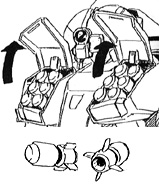 Internal:
Internal:
(VR-041)
- 2 x GR-103, a RPG launcher built into the Cyclone's chest. The launcher holds six 60mm x 150mm Recluse terminally laser- and radar-guided rocket-propelled grenades in each side of the chest for a total of twelve. The missiles are armor piercing or high explosive, and have a range of 0.8 km.
(VR-038 and VR-052)
External:
(VR-055)
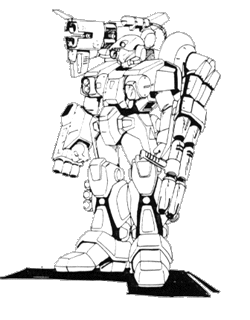
- 1 x EP-41R double-barreled rapid fire pulse particle gun, firing 1.0 MJ shots at a maximum sustained rate of the rate of 30 shots per minute, but capable of instantaneous rate of fire of 300 shots per minute. This weapon is mounted on the right shoulder of the Devastator Cyclone, and is capable of +60 to -30 degree traverse in altitude, and a 15 degree traverse in azimuth. The weapon is powered from its own dedicated protoculture cell, and is somewhat unreliable, tending to overheat at maximum firing rate. The gun machinery requires the removal of the Cyclone's flip-up targeting sensor, which is replaced by a fixed monocular head piece attached to a modified CVR helmet.
- 2 x GR-10 triple-tube rocket-propelled grenade launchers, mounted to the outer leg portion of the CVR-4 armor, for a total of six tubes, with a single missile in each tube. Guided by the Cyclone's internal sensors, this weapon fires the same Recluse projectiles as the GR-103.
(All Cyclones mount one of the following additional packages)
A Model:
C Model:
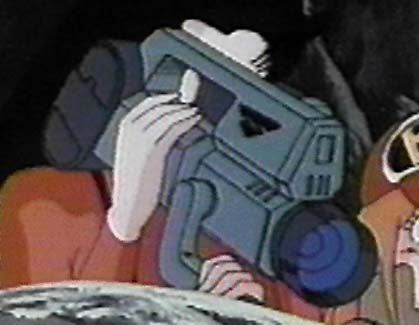
- 1 x M312SC Military recording
camera, for archival and reconnaissance in battlefield
environments. Camera set includes IR-illuminator, and night-vision capability on a high-resolution wide-bandwidth CCD chip and six low-resolution narrow-band CCDs for full optical, near- and far-IR, and UV color imaging. Camera is capable of digitally storing thirty minutes of footage at highest resolution, or twelve hours at the lowest. Unit is also capable of three-color hard-copy production
of single frames. Camera mounts to the right shoulder hardpoint in all modes.
F Model:

- 2 x GR-97 dual 45mm x 260mm Scorpion mini-missile tube mounted on the forearm plates (front wheel covers). The two Scorpion missiles are laser-guided, have plasma warheads, and a range of 1.7 km.
H Model:
- 2 x CADS-1, long ceramic swords that extend from round shields mounted on the forearms (front wheel covers). The swords vibrate at an extremely high frequency and can cut through most armors. The shields are covered in an advanced Chobham armor for additional protection against slow-moving explosive rounds and Invid annihilation disks. This model is mainly used for special operations, and is almost exclusively used on the VR-041.
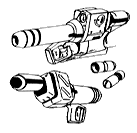
L Model:
- 1 x RL-6, a hand-held rocket launcher that fires Tarantula Rocket-Propelled Grenades, similar in range and yield to the Recluse projectiles fired by the GR-103. It has a six missile payload. Weapon is fully usable without the Cyclone, but must be fired without benefit of the uplink to the Cyclone's targeting system. Weapon mounts to the interior of the right forearm plate (front wheel cover) in Battloid, and on the right shoulder hardpoint in Cycle mode.
M model:
- 1 x M122MK field medical kit mounted on the right forearm plate (right front wheel cover) containing numerous field-expedient medical supplies, including sterile blood-plasma substitutes, antibiotics, bandages, pressure bandages, burn treatments, and so forth.
- 1 x M132DK field medical diagnostic apparatus. System is capable of monitoring a wide array of body functions, and includes a defibrilator and miniature artificial blood circulation and oxygenation system.
R Model (seen exclusively with the VR-055):
- 1 x EP-42, a double-barreled 60mm pulse beam gun mounted to the left forearm plate. Deriving its power from the Cyclone's main generator, the EP-42 is capable of firing 3.0 MJ pulses from each barrel at a total rate of fire of twenty shots per minute. This weapon is based upon a miniaturized version of the gun machinery of the Alpha's EP-13. Like the
EP-41R, this weapon is prone to malfunction.
- 1 x GR-105 triple 45mm x 260mm Scorpion mini-missile tube mounted on the right front wheel cover, with one set of reloads. The six Scorpion missiles are laser-guided, have plasma warheads, and a range of 1.7 km. Mounting of this system in Battloid mode requires a unique piece of forearm armor that is part of the CVR-4, but not the -3.
T Model:
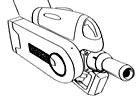
- 1 x EP-40, a 40mm pulse particle beam gun mounted in place of the right forearm plate (right front wheel cover) of the Cyclone. Firing 750 kJ per shot, it can pierce almost any armor, and stores 45 rounds per energy magazine. Magazines can recharge from the Cyclone's main generator, but at a slow rate. Weapon is also targetable from Cycle mode, though the arc of fire is limited. A targeting camera is mounted in the front, uplinking with the Cyclone's main targeting system. Action is semi-automatic. This weapon is appreciably lighter than the EP-37, at 4.5kg, but is still somewhat difficult to hold in prolonged combat without the added strength of the Cyclone.
Hand-held:

- A pilot may use a hand-held weapon in any hand not already occupied with a Cyclone weapon mounted on the inner forearm plate (such as the EP-37, EP-40, or RL-6). The most typical weapon carried is the Mars Gallant H90 in rifle mode.
- 1 x EP-37 60mm hand-held particle beam gun, capable of piercing almost any armor and doing devastating amounts of damage; each shot is rated at around 1.5 MJ. This weapon holds 15 rounds per energy magazine. Alternatively, the weapon may fire 30 shots at the lower energy setting of 750 kJ per shot. When used without the Cyclone system, the weapon is heavy (11.3 kg), and is difficult to aim. However, because servos connect the forearm plate/front wheel cover to the Cyclone torso (these servos, which double as shock absorbers in motorcycle mode, are often omitted from Battloid-mode sketches of the vehicle), the pilot's strength is augmented for all items physically mounted to the forearm plate, ameliorating the difficulty in using the weapon. Additionally, the gun possesses a sighting camera which can link into the Cyclone's targeting system. Weapon is mounted to the inside of the right forearm plate (right front wheel cover) in Battloid and the right shoulder hard-point in Cycle mode. Action is semi-automatic.
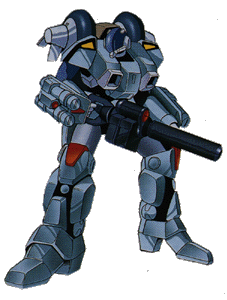
- 1 x M-100 12.7mm hand-held 3-barrel rotating gatling machine gun, used for anti-personnel use. This weapon uses 2 magazines containing 100 rounds each and can fire at a rate of 600 rounds per minute. The weapon also includes a large sensor/designator that can tie into the Cyclone's targeting system to assist in aiming. The Cyclone system's arm servos provide the strength to operate the weapon as well as dampening the recoil to allow this weapon to be used one or two handed. When used without the Cyclone system, the weapon is heavy, difficult to aim, and likely to cause significant injury to the operator from the recoil, though a port is built into the underside of the weapon that accepts a standard tripod.
VIII. Cyclone Armor:
The armor of the Cyclone is composed of an advanced titanium-steel alloy.
The armor on the Bartley stops all small arms fire, provides fair
protection against heavier infantry weapons, such as a 12.7mm machinegun
round, and poor resistance to light mecha-mounted weaponry, such as the
Zentraedi 22.3mm HE autocannon round (though the pilot will be badly
concussed). The armor on all other models is significantly better, but the
added weight reduces the vehicle's maneuverability. Field tests show that a
Cyclone can sometimes withstand two or more blasts from Invid plasma guns.
Vulnerable areas of the pilot are part of the upper arms, which are unarmored.
The thighs and helmet are not protected by the Cyclone, but are covered by the
CVR armor. Nuclear, biological, and chemical protection is limited to that
provided by the CVR armor.
IX. Development:
The Cyclone is definitely the most innovative design in multiform mecha
since the renovation of the SDF-1. The most recent series of wars, beginning
with the Gulf War in 1991 and continuing through the global civil wars
through the next decade taught the military high commands that basic
infantry units suffered great liabilities: they were relatively slow
compared to armor and mecha, and they were too vulnerable to even the
smallest weapons. Though the UNDF tried to improve upon the latter problem,
the clunky HES body armor was rather
immobile. The RDF made the first step towards improving things with the
introduction of the its first hard armor, the
CVR-1. The latter met with some success, but it became apparent that a
man-sized mecha would be of invaluable use to the infantryman as a weapons
platform, as would a personal vehicle.
Dr. Emil Lang fulfilled this desire with the Cyclone, a Veritech motorcycle
that attached itself to a slightly modified version of the CVR hard armor.
Adopted in 2032 by the REF Marines and Army as their primary infantry
vehicle, and as security mecha and an emergency vehicle for downed pilots
by the Navy and Air Force branches, this small, nimble mecha has seen
service on hundreds of worlds and all theaters of engagement. Prior to this,
the Cyclone was available in more limited numbers, mainly for use in special
forces units, and several hundred were brought to Earth with 3rd Planetary Corps in 2030.
The Cyclone is a tough, durable piece of hardware that maximizes the
versatility, survivability, and lethality of an individual soldier. The
weapons systems are modular, accurate, and flexible, and the motorcycle mode
is unmatched in its role. In all, one can expect to see more mecha like this
in the future.
The earliest production model to be introduced was the VR-038 Bartley; though it began its life as a test platform for the Cyclone concept, it remained on as a light combat unit, mainly used by the smaller female soldiers (for whom the weight and heavier armor of the later models - at least in storage box-mode - was unmanageable), and by battlefield observers and medics. Attempts to improve the overall armor of both the main torso section of the Cyclone, and the
leg sections in the CVR-3 armor, as well as a need to introduce a deadlier weapons package, led to the VR-041. With twelve rocket-propelled grenades standard, and an ever-widening array of weapons systems mountable to the forearms, the -041, or "Blowsperior", was a capable and deadly machine. Unfortunately, the production of this type of Cyclone was extremely costly, and it suffered from a sensor package that left much to be desired. Furthermore, extensive training was required to safely operate this mecha's internal rocket-propelled grenade launcher. As mass production of the Cyclone loomed in the near future, the decision was made to develop a third model, the -052 Battler, which would sacrifice all internal weapons in favor of newly-developed weapons for the forearm plates and a dramatically improved internal sensor suite. Because of the increased ease of construction, the -052 became the standard infantryman's mecha of the later REF ground forces and the standard emergency vehicle for Air Force and Naval pilots, relegating the -041 to the role of the weapon issued to anti-armor specialists in the ground forces. In late 2043, a new Cyclone was unveiled - the VR-055 Devastator. Though it was far more costly and difficult to produce than even the Blowsperior, the -055
lived up to its name. Coupled with the new -R model external weapons package and sporting a modified CVR armor, the Devastator had the equivalent firepower of an entire squad of conventional Cyclones. Unfortunately, problems with the two largest guns were never resolved, adding to the problem of its enormous cost of manufacture, and no more than a hundred Devastators ever saw service.
See additional design notes.
Go to additional image gallery.
Return to REF Veritech Index.
Return to Robotech Reference Guide Home Page.
Robotech (R) is the property of Harmony Gold. This document is in no
way intended to infringe upon their rights.
Content by Pieter Thomassen and Peter Walker, with Rob Morgenstern
HTML by Robert Morgenstern (rmorgens@ieee.org)
Copyright © 1999, 1998, 1997, 1995 Robert Morgenstern, Pieter Thomassen, Peter Walker






 Internal:
Internal:





